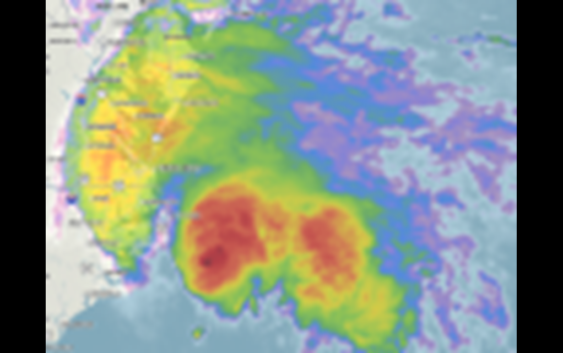- National memorial to honor NC firefighter who died on duty during Hurricane Helene
- Gov. Josh Stein extends State of Emergency for western NC wildfires
- Gov. Stein extends state of emergency for NC wildfire threat
- Governor Stein extends state of emergency for NC wildfire threat
- Governor Stein extends emergency in 34 NC counties amid wildfire threat
How often do early tropical storms or hurricanes hit the continental US?

Tropical Storm Arthur flirted with the North Carolina coast Monday, with its center making it as close as just 20 miles from the easternmost part of the Outer Banks. If the storm had reached landfall, it would have been just the fourth tropical or subtropical storm to hit the continental United States before June since 1990. Alberto last year was the most recent.
Hurricanes are even less likely to hit the continental U.S. early in the Atlantic Basin hurricane season. A hurricane hasn’t made U.S. mainland landfall before July since 1986 when Hurricane Bonnie hit Texas on June 26, according to the National Oceanic and Atmospheric Administration (NOAA). There have been just three other such hurricanes since 1945 and the earliest hurricane to strike the U.S. was Alma, which hit Florida on June 9, 1966.
“The ocean temperatures are not warm enough this early to actually produce a hurricane in most cases,” said AccuWeather Founder and CEO Dr. Joel N. Myers. “Conditions conducive to a hurricane developing would have to line up just perfectly, but it can happen.”
The arrival of Arthur does, however, extend a streak of relatively early developing named tropical or subtropical storms, even if they don’t hit the U.S. mainland. This is now the sixth straight year that a named storm has developed before the official start of the hurricane season, which runs from June 1 through Nov. 30.
“The increase in preseason storms is related to the warmer-than-normal water that continues to show up in the Straits of Florida, Bahamas and in parts of the Gulf of Mexico and northern Caribbean,” said AccuWeather’s lead hurricane expert Dan Kottlowski. “This is where we have seen most of the preseason development.
“The warm water is in part due to the warm phase of the AMO [Atlantic Multidecadal Oscillation] but could also be due to a warming atmosphere,” said Kottlowski, referring to the ongoing series of long-duration changes in the sea surface temperature of the North Atlantic Ocean, with cool and warm phases that may last 20 to 40 years at a time, according to NOAA. “The ocean is a heat sink and is absorbing much of the excess warming that is taking place in the atmosphere. All ocean basins have been reporting above-normal sea surface temperatures the past few years.”
Tropical and subtropical storms are not typically as dangerous as hurricanes, but they can still pack a punch. A tropical storm has maximum sustained surface winds ranging from 39 to 73 mph, while a hurricane’s maximum sustained surface winds are at least 74 mph and a major hurricane – a Category 3 or greater – has maximum sustained winds of 111 mph or higher.
“Tropical storms could still produce significant flooding from rain – that’s the main threat – but they’re almost always in the less-than-one category on the AccuWeather RealImpact™Scale for Hurricanes,” said Myers, referencing the company’s unique scale introduced last year to help people and businesses better understand the full impact of hurricanes. “And we know more fatalities from tropical storms occur due to flooding from storm surge or heavy rains than due to high winds.”
Tropical Storm Arthur was a less-than-one on AccuWeather’s six-point scale with ratings of less-than-one and 1 to 5.
The six-year stretch of early storms has brought discussions of whether to change the start date for hurricane season. The season’s dates have been set as June 1 to Nov. 30 since 1965. The initial dates first chosen in 1941 were June 16 to Oct. 31, but the dates were subsequently changed five times in the ensuing 20 years before remaining unchanged for the last 55 years, according to Kottlowski.
“The only advantage I see in going to maybe May 15 or May 1 is to attempt to get people to get ready for the season earlier,” said Kottlowski. “But I’m perfectly fine with keeping the start of the season at June 1.”
It’s all academic, Myers points out, considering most hurricanes occur from August through October – the season’s peak months – and that 98.4 percent of Atlantic Basin hurricanes, which includes the Atlantic Ocean, Gulf of Mexico and Caribbean Sea, have occurred June 1 through Nov. 30, and all of the 297 hurricanes that have made landfall in the continental U.S. since 1851 occurred during the hurricane season as presently defined.
“The debate as to what the starting date of the season should be is secondary,” Myers said. “To say it starts on this day and ends on that day is arbitrary. More hurricanes occur on average in September than any month, next is August and third in frequency is October. People can play with the dates, but the damage and impact has not shifted seasonally that much.”
Keep checking back on AccuWeather.com and stay tuned to the AccuWeather Network on DirecTV, Frontier and Verizon Fios.